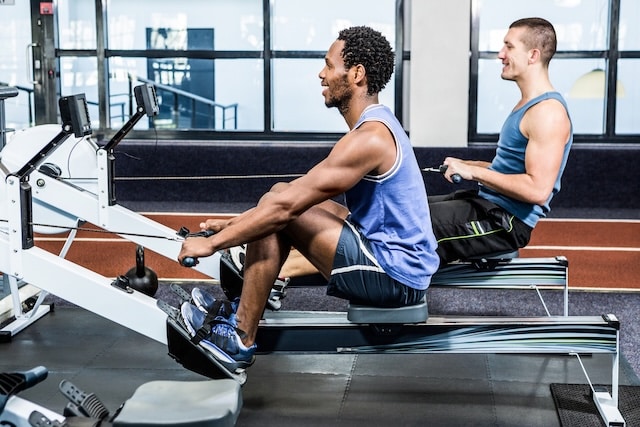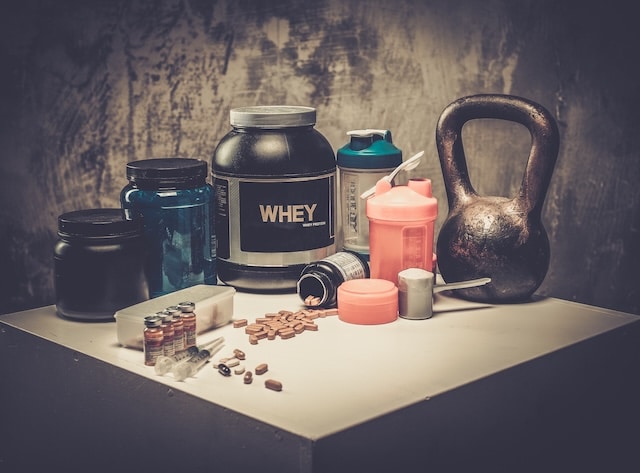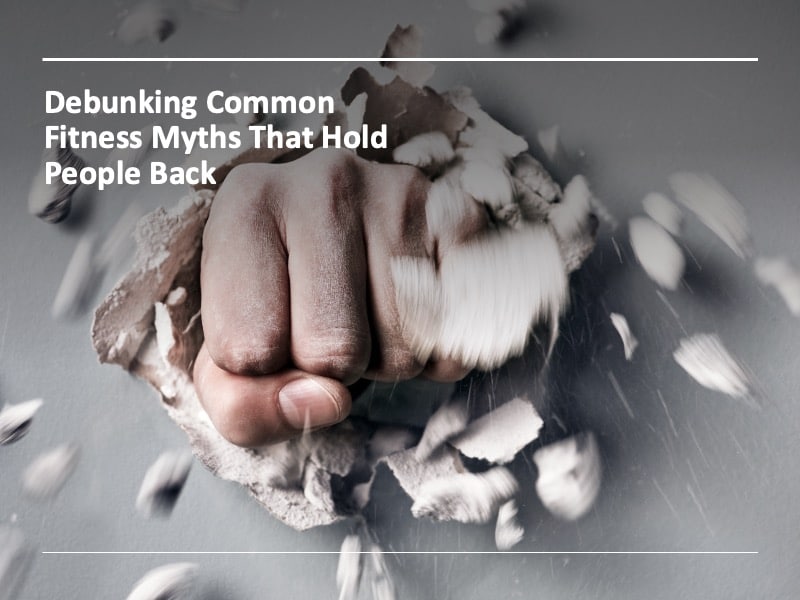Debunking Common Fitness Myths That Hold People Back
The fitness world is full of information, guidance, and tips to assist you in achieving your objectives.
Yet, some of this guidance relies on fitness myths that could be sabotaging you.
Common fitness myths can cause confusion and frustration, particularly when you’re doing the work but not receiving the results you anticipate.
As someone who has spent over a decade as a professional athlete and earned a master’s degree in Nutrition Education, I’ve seen firsthand how prevalant and damaging common fitness myths can be.
The key to long-term success in health and fitness is understanding what actually works and why, and that starts with breaking down misinformation and building knowledge rooted in credible science and real-world experience.
It’s time to get the facts straight and debunk some of the most prevalent myths in the fitness industry.
By knowing these common fitness myths, you can better approach your fitness regimen and make wiser choices for your well-being.
Why Are Fitness Myths So Common?
Fitness myths are widespread because they often sound logical, are repeated frequently, and are packaged in simplified advice that’s easier to sell than complex truths.
Many myths are perpetuated by outdated science, anecdotal experiences, and misleading marketing from the health and wellness industry.
When celebrities or influencers promote a particular training method, supplement, or “hack,” people are often eager to believe it, especially if it promises fast results.
Another reason common fitness myths persist is the oversaturation of content online.
With so many voices in the fitness space, it becomes difficult for the average person to distinguish between evidence-based information and pseudoscience.
Even well-meaning fitness professionals may repeat myths they heard early in their careers if they haven’t kept up with the latest exercise science research.
These misconceptions thrive in echo chambers where people share quick tips without questioning their accuracy.
Unfortunately, following these common myths can lead to plateaus, burnout, or even injury.
Common Fitness Myths vs Facts: Analyzing the Evidence

Some fitness myths just won’t die, no matter how much science proves them wrong.
They’re repeated in gyms, shared on social media, and even echoed by well-meaning trainers.
But holding onto these outdated beliefs can seriously stall your progress and lead to burnout, injury, or disappointment.
Understanding what’s fact and what’s fiction is essential if you want to train smarter and get real, lasting results.
Let’s break down some of the most stubborn myths in the fitness world and explain what the evidence actually shows.
1.) More Is Always Better
One of the most common fitness myths is that the more you exercise, the better the outcome.
While consistency is important, overtraining can have the opposite effect.
Your body requires rest time, particularly after strenuous exercise.
Failing to provide it with that rest can leave you open to injury, burnout, and decreased performance.
Research shows that excessive training without adequate rest disrupts the body’s ability to recover, causing fatigue, hormonal imbalance, and immune suppression (Kreher & Schwartz, 2012).
Studies also link high training frequency with overuse injuries and the need for structured rest periods to optimize performance (Verstappen et al., 2021; Brenner et al., 2024).
You must balance pushing your body and providing it with the time it needs to rest and rebuild itself so it can become stronger.
Rest days are as necessary as workout days, as they give your muscles time to repair and strengthen themselves.
Overtraining will not increase progress, it will hinder you.
2.) Women Should Not Lift Heavy Weights

Another prevalent fitness myth is that women should not lift heavy weights because it will make them muscle-bound.
This simply isn’t the case.
Women inherently have lower testosterone levels, which makes it much more difficult for them to achieve large muscle mass.
In reality, strength training benefits women by increasing bone density, metabolism, and body tone (Kraemer et al., 2025).
Lifting heavier weights in a controlled, progressive method can result in lean muscle gain and strength, not bulk.
Weightlifting is due for a comeback as a part of an overall fitness program.
3.) Cardio Is the Only Way to Burn Fat

Cardio workouts such as running, cycling, and swimming are usually considered the best means of burning fat.
Nevertheless, a sole reliance on cardio can restrict the general efficiency of a fat loss program.
Although cardio is efficient for burning calories, strength training also has an important role to play in fat loss.
Gaining lean muscle by weight training raises your metabolism, enabling you to burn more calories at rest (Westcott, 2012).
The secret to fat loss is having a mix of both strength and cardio exercises.
By varying your exercise routine, you are able to have a better-balanced and sustainable strategy for burning fat.
4.) You Have to Consume Protein Right After Exercise
It is believed that there is a need to consume protein within a few minutes after an exercise session for the recovery and growth of muscles.
The protein absorption myth says that if you do not consume protein immediately following exercise, you will be missing out on muscle-building potential.
In reality, as long as you’re consuming an adequate amount of protein for building muscle throughout the day, your body will have plenty of time to repair muscle tissue, regardless of exact timing.
Though protein is necessary for muscle repair, the notion of a precise “window” of protein consumption is a myth.
Studies indicate that the body has a substantially longer window, several hours after exercise, during which protein can be absorbed (Schoenfeld & Aragon, 2018).
5.) Stretching Before a Workout Prevents Injury
Stretching before a workout is often seen as an essential way to prevent injury.
Although flexibility is indeed critical, static stretching (holding stretches for lengthy durations) prior to exercise can even lower strength and elevate the risk of injury.
Dynamic stretching or warming up with light aerobic exercises prior to a workout is more effective in getting your muscles ready for activity.
Dynamic stretches like leg swings or arm circles stimulate your muscles and boost circulation, preparing them for more intense activity.
Static stretching is more appropriate after the workout when the muscles are already warm.
6.) Supplements Are a Magic Solution

Using supplements as a magical solution to health and fitness goals is one of the most common diet myths.
Supplements are often used by many fitness enthusiasts who feel that they will give them instant results with the least amount of effort.
While some supplements, like protein powders or vitamins, can help you achieve your fitness objectives, they are not a magic solution.
Supplements should never be used to substitute a balanced diet and regular exercise regimen.
Rather, they should be utilized to supplement healthy eating habits and make sure that your body is receiving the nutrients it requires.
There is no replacement for hard work, a well-balanced diet, and rest.
Supplements are merely a tool to help your progress, not a way to bypass success.
7.) You Can Spot-Reduce Fat
One of the most common weight loss myths is the idea that you can target fat loss from a specific area, like doing endless crunches to flatten your stomach or triceps kickbacks to tone your arms.
However, research shows that fat loss doesn’t work that way.
Fat is lost systemically, and your body decides where to burn it based on genetics and hormones, not the exercises you perform (Ramírez-Campillo et al., 2013).
While strengthening exercises improve muscle tone underneath fat stores, they won’t selectively burn fat in that area.
Instead of focusing on one trouble zone, prioritize full-body resistance training, moderate cardio, and a consistent nutrition strategy to reduce overall body fat.
8.) Sweating Means You’re Burning More Fat
Sweating is often treated as a badge of honor, with many assuming that the more you sweat, the more fat you’ve burned.
But sweat is not a direct measure of how many calories you’ve burned or how hard you’ve worked.
It’s simply your body’s way of regulating temperature.
External factors like heat, humidity, and individual sweat rates play a much larger role than exercise intensity alone.
Fat loss comes from maintaining a consistent calorie deficit, not from how much you sweat.
Focus on quality workouts over sweat-drenched sessions.
9.) You Need to Be Sore After Every Workout
Many people use muscle soreness as a sign that their workout was effective. But constantly feeling sore isn’t a reliable marker of progress or muscle growth.
DOMS (Delayed Onset Muscle Soreness) typically occurs when your body encounters a new or intense stimulus.
Once your body adapts, you may experience less soreness even if you’re still making gains.
In fact, training through constant soreness can lead to overtraining, poor recovery, and increased injury risk.
Progress is better measured by improved performance, consistency, and how well your body recovers, not just how sore you feel.
10.) You Have to Be in the Gym to Get Fit

The belief that serious fitness only happens in a gym is outdated.
While gyms offer useful tools, there are plenty of ways to get fit without going to the gym.
Bodyweight exercises, resistance bands, walking, hiking, and even structured home workouts can deliver impressive results when done with intention and consistency.
Many people make remarkable progress without ever stepping foot in a commercial gym.
Fitness is about movement, progression, and consistency, not your location.
The best workout is the one you’ll actually stick with, whether it’s at home, outside, or in a gym.
11.) Bodybuilding Causes Hair Loss
A widespread belief is that intense weight training or bodybuilding causes hair loss, leading many to associate muscle growth with thinning hair.
In reality, the connection between bodybuilding and hair loss usually has less to do with lifting weights and more to do with hormonal influences, specifically, the misuse of anabolic steroids.
Steroid use can increase levels of dihydrotestosterone (DHT), a hormone linked to male pattern baldness in genetically susceptible individuals.
However, natural bodybuilding or resistance training alone does not directly cause hair loss.
If you’re training naturally and maintaining a balanced diet, there’s no strong evidence that your workout regimen will make your hair fall out.
This common fitness myth likely persists because some bodybuilders who use performance-enhancing drugs also experience hair thinning, but correlation doesn’t equal causation.
Final Thoughts: Biggest Fitness Myths Debunked
Fitness is a continuous process that needs the correct information, patience, and commitment.
Most common fitness myths can prevent individuals from achieving their true potential and result in confusion and inefficient practice.
By combating everyday misconceptions, including the myth of overtraining, the myth of protein absorption, and that cardiovascular exercise is the sole route for burning fat, individuals become better informed.
One must pay attention to a centered approach that includes rest, strength training, and nutrition.
With the proper attitude and a superior knowledge of fitness, it is possible for anyone to accomplish their fitness objectives and have a healthier, more energetic lifestyle.



